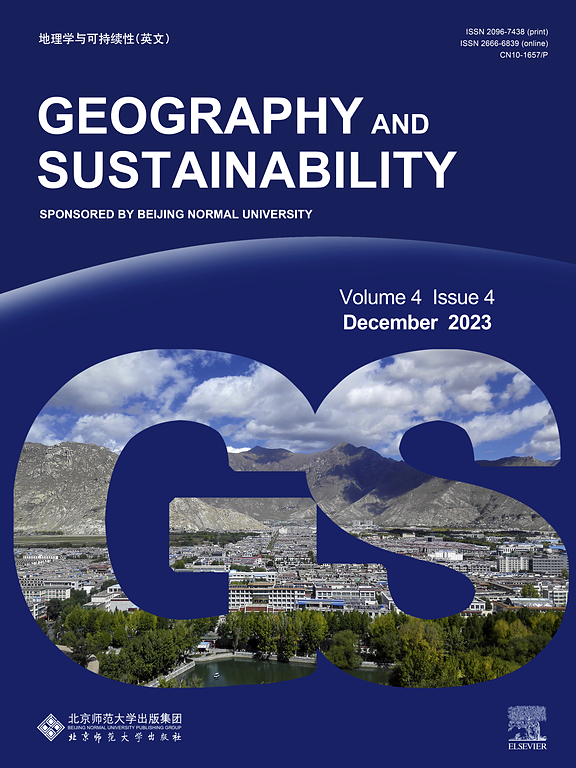Associations between individuals’ daily carbon footprints and exposures to air pollution, noise, and greenspace in space and time
IF 8
1区 环境科学与生态学
Q1 GEOGRAPHY, PHYSICAL
引用次数: 0
Abstract
To mitigate the catastrophic impacts of climate change, many measures and strategies have been designed and implemented to encourage people to change their daily behaviors for a low-carbon society transition. However, most people generate carbon emissions through their daily activities in space and time. They are also exposed to multiple environmental factors (e.g., air pollution, noise, and greenspace). Changing people’s behaviors to reduce carbon emissions can also influence their multiple environmental exposures and further influence their health outcomes. Thus, this study seeks to examine the associations between individuals’ daily carbon footprints and their exposures to multiple environmental factors (i.e., air pollution, noise, and greenspace) across different spatial and temporal contexts using individual-level data collected by portable real-time sensors, an activity-travel diary, and a questionnaire from four communities in Hong Kong. The results first indicated that individuals’ carbon footprints of daily activities varied across different spatial and temporal contexts, with home and nighttime having the highest estimated carbon footprints. We also found that activity carbon footprints have a positive association with PM2.5, which is particularly strong at home and from morning to nighttime, and mixed associations with noise (positive at home and nighttime, while negative in other places and during travel, from morning to afternoon). Besides, carbon footprints also have consistent negative associations with shrubland and woodland across different spatial and temporal contexts. The findings can provide essential insights into effective measures for promoting the transition to a low-carbon society .

个人日常碳足迹与暴露于空气污染、噪音和绿色空间在空间和时间上的关系
为了减轻气候变化的灾难性影响,已经设计和实施了许多措施和战略,以鼓励人们改变他们的日常行为,向低碳社会过渡。然而,大多数人在空间和时间上通过日常活动产生碳排放。他们还暴露于多种环境因素(例如,空气污染、噪音和绿地)。改变人们的行为以减少碳排放也可以影响他们的多重环境暴露,并进一步影响他们的健康结果。因此,本研究旨在利用便携式实时传感器、活动旅行日记和来自香港四个社区的问卷收集的个人层面数据,研究个人日常碳足迹与其在不同时空背景下暴露于多种环境因素(即空气污染、噪音和绿地)之间的关系。研究结果首先表明,个体日常活动的碳足迹在不同的时空背景下存在差异,其中家庭和夜间的碳足迹估计最高。我们还发现,活动碳足迹与PM2.5呈正相关,在家中和从早上到晚上尤其强烈,与噪音有混合关联(在家中和夜间为正,而在其他地方和旅行期间,从早上到下午为负)。此外,在不同时空背景下,碳足迹与灌丛和林地的负相关关系也一致。研究结果可以为促进向低碳社会过渡的有效措施提供重要见解。
本文章由计算机程序翻译,如有差异,请以英文原文为准。
求助全文
约1分钟内获得全文
求助全文
来源期刊

Geography and Sustainability
Social Sciences-Geography, Planning and Development
CiteScore
16.70
自引率
3.10%
发文量
32
审稿时长
41 days
期刊介绍:
Geography and Sustainability serves as a central hub for interdisciplinary research and education aimed at promoting sustainable development from an integrated geography perspective. By bridging natural and human sciences, the journal fosters broader analysis and innovative thinking on global and regional sustainability issues.
Geography and Sustainability welcomes original, high-quality research articles, review articles, short communications, technical comments, perspective articles and editorials on the following themes:
Geographical Processes: Interactions with and between water, soil, atmosphere and the biosphere and their spatio-temporal variations;
Human-Environmental Systems: Interactions between humans and the environment, resilience of socio-ecological systems and vulnerability;
Ecosystem Services and Human Wellbeing: Ecosystem structure, processes, services and their linkages with human wellbeing;
Sustainable Development: Theory, practice and critical challenges in sustainable development.
 求助内容:
求助内容: 应助结果提醒方式:
应助结果提醒方式:


